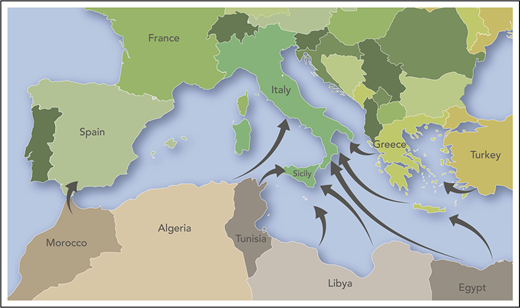In this issue of Blood, De Franceschi et al summarize the recent refugee crisis affecting southern Europe, from the standpoint of providing care for refugees arriving in Italy with unrecognized hemoglobin disorders.1
Refugee flow across the Mediterranean Sea into European countries. From the Office of the United Nations High Commissioner for Refugees. Professional illustration by Somersault18:24.
Refugee flow across the Mediterranean Sea into European countries. From the Office of the United Nations High Commissioner for Refugees. Professional illustration by Somersault18:24.
There are an estimated 78 million immigrants including a large number of refugees living in Europe, and the highest flows are into Germany, the United Kingdom, France, Italy, and Spain. In the current European refugee crisis, many travel by land, but thousands cross the Mediterranean Sea from West Africa, North Africa, and the Middle East to reach the southern coast of Italy or the Greek islands (see figure). In Italy, the highest numbers of refugees currently come from West African countries Senegal and Nigeria, as well as Morocco, Egypt, and Tunisia in North Africa and Syria in the Middle East. These refugees, unlike migrants or immigrants who voluntarily move to another country seeking economic or educational opportunities, are forced to flee their homes unexpectedly because of war, violence, or persecution.
Embedded within this crushing humanitarian crisis, which most visibly involves the questions of proper immigration and asylum status of the refugees, is the fact that many arrive sick and without any financial or emotional means of support. Their travel conditions invariably involve excessive heat, dehydration, malnutrition, and psychological stress, all of which can worsen preexisting medical conditions. From a hematologist’s perspective, it is noteworthy that hemoglobinopathies, especially sickle cell disease (SCD), are relatively common, based on the countries of origin.
De Franceschi et al investigated the burden and impact of refugees with hemoglobin disorders who migrated to Italy. Between 2014 and 2017, >600 000 refugees arrived and were assimilated through a multitiered system involving coastal intake centers and secondary relocation centers across the country. Refugees were routinely screened for communicable diseases and administered vaccinations but were not tested for SCD or other noncommunicable disorders. Anticipating that individuals with SCD could come through and present with acute complications, Italian hematologists designed algorithms and provided special training for a large number of emergency departments and frontline health care providers to help them recognize signs and symptoms of acute sickle-related events and provide necessary care.2
In their report, the Italian investigators describe 70 refugees, both children and adults, who presented with acute symptoms that led to the diagnosis of homozygous sickle cell anemia or other forms of SCD. The most common presenting conditions were vasoocclusive pain, anemia, and acute chest syndrome. Proper identification and diagnosis of these patients then allowed them to be referred to specialty care at comprehensive sickle cell centers. Access to specialty care, including hydroxyurea therapy, which has been shown to provide excellent laboratory and clinical outcomes for individuals with SCD from West Africa living in Italy,3 was not readily available in their home countries.
The authors then describe a small pilot study using a point-of-care (POC) diagnostic device that can identify individuals with common hemoglobin variants HbS or HbC. There are several new POC devices for sickle cell screening with varying degrees of accuracy and simplicity of interpretation.4 However, in low-resource settings, it is equally critical that a POC device be inexpensive and robust. Using a lateral flow immunoassay (SickleSCAN), remarkably high rates of either hemoglobin carrier (20%) or disease (3%) were identified among newly arriving refugees. Importantly, none of these individuals reported knowing previously about their underlying hemoglobinopathy.
Going forward, it seems clear that this bleak humanitarian refugee crisis will persist. On the basis of the findings of De Franceschi et al, incoming refugees should be tested for SCD, and then subsequent offspring should be tested using universal newborn screening, as recently advocated by a consensus conference of European hematologists.5 Whether such screening and testing should use POC or standardized laboratory-based techniques like isoelectric focusing remains to be determined. Although the burden of Middle Eastern and African refugees is far greater for Europe, a steady stream of individuals with SCD also arrive in the United States,6 and in all regions, the best outcomes require prospective planning, a thoughtful approach, and adequate resources.
Within sub-Saharan Africa, there is reason to be cautiously optimistic about diagnostic and treatment resources for individuals with SCD. Since a harsh assessment by the World Health Organization less than a decade ago,7 there has been substantial progress. Creative partnerships connecting academia, industry, and government are helping to promote research that improves clinical care and builds local capacity.8 Support from the American Society of Hematology, the National Institutes of Health, the Doris Duke Charitable Foundation, the pharmaceutical industry, and other organizations has led to tangible successes, particularly with regard to the safety, feasibility, and benefits of hydroxyurea in sub-Saharan Africa.9,10
In 1883, the American poet Emma Lazarus wrote “The New Colossus,” which compared the newly built Statue of Liberty to the ancient Greek giant. In the final portion of her sonnet, Lazarus included a spoken message from the new figure: “Give me your tired, your poor, your huddled masses yearning to breathe free.” She thus offered an open invitation for immigrants who bring only themselves and their dreams. The words of this literary masterpiece were meaningful to the United States more than a century ago, but they are also relevant to the current European refugee crisis. With proper planning and a bold vision, even tired and poor refugees with SCD who arrive as huddled masses can find a new and healthier life.
Conflict-of-interest disclosure: The authors declare no competing financial interests.

